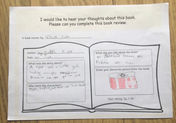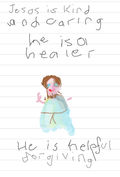

Year 1
Welcome to Year 1
Welcome to the Year 1 class page. This page will provide opportunities for us to share some of the amazing learning that takes place within our class.
Important days to remember:
PE: Monday and Wednesday
Swimming: Friday (summer term only)
Please bring your reading book and home/school link diary each day as this is an important and efficient way to communicate with your class teacher.
Reading
As a school, we are committed to helping every child fulfil their full potential. Developing the skill and enjoyment of reading is essential in enabling our children to become successful learners. It is crucial that you aim to read with your child at least 4 times per week. This will help their learning across the curriculum and promotes their self-esteem.
Your support at home is, of course, crucial to the successful development of your child’s reading. Your child has been given a ‘Home School Link Book’ for you to record in every time you read with your child. This will help their learning across the curriculum and promotes their self-esteem. There are lots of ways in which you can help your child at home; we have listed a few ideas below:
-
Listen to your child read
-
Read a story to your child
-
Share a book together – take it in turns to read pages
-
Before you begin a book – look at the cover – ask your child to predict what the book will be about
-
Stop at a point in the story – ask your child to predict what will happen next. Why do they think that?
-
Make your own predictions and explain your reasons. Remember children learn by imitating others.
-
Look through a book first, only looking at the illustrations – try and work out what is going to happen
-
At the end of the book – discuss ‘who is your favorite character?’ and ‘did you enjoy this book? Why?’
-
Make up a quiz about the book. Or even better ask your child to ask you questions!
-
Pretend you are a character. Get the children to ask you questions and answer in role. Swap over to allow them to have a go at ‘being’ the character.
-
Can you find the word [put your own word here] anywhere in the book?
-
Make up stories together relating to what happened before or after the story took place.
-
Practice reading the 100 and next 200 High Frequency words from the reading diary.
Autumn 1
During the first half term of Year 1 we will continue to provide lots of opportunities to explore different learning environments. Some of the areas we have within the classroom are; a reading corner, role-play area, construction area, water and sand, creative area, writing and numeracy table. Each week the activities set up will link with our current topic.
This term we will be exploring a variety of traditional tales and meet our favourite characters from the stories whilst completing the challenges set by them. So far in year 1 we have fed the greedy wolf from ‘Little Red Riding Hood’ a variety of nouns and we have used adjectives to create a detailed wanted poster after the wolf went missing. Also, in math’s we have used our knowledge of number to help the little pig from the story of ‘The Three Little Pigs’ to build his house of bricks. We have read the ‘True Story of the Three Little Pigs’ and composed questions to ask the wolf about his version of events. Next, we made gingerbread men to find they had escaped overnight from the classroom but they did return after we helped the ‘Gingerbread Man’ to complete the number bonds. In science, we have discovered the importance of our 5 senses.
Take a look at our learning journey so far:
Autumn 2
This half term begins with the Gunpowder Plot as the children will discover Britain’s historic events that led to the celebration of Bonfire Night. The children will encounter drama to help with their understanding of the Plot which will lead to them onto the writing of this historic story.
The term will continue with the story 'Owl Babies'. During this topic we will become scientists and identify a variety of common animals that are carnivores, herbivores and omnivores. The children will use simple fieldwork and observational skills to study the geography of our school and relate this to the habitats of our wildlife.
In English children will be engaging in extended writing as they rewrite the ending of the story becoming authors themselves.
The term will end with the topic 'The Time Machine' where the children will go back in time and discover the Christian message that illuminates from the nativity story. During this topic the children will engage in writing a news report, a letter and will write the story from the perspective of the donkey that carried Mary into Bethlehem.
It is during this half term that the children are performing the Christmas Nativity which allows the opportunity for music to be taught in a way that the children use their voices expressively and creatively.

Spring 1
The Price and the Pauper
Following the whole school theatre trip to watch amazing production of The Prince and the Pauper the Year 1 children have been busy exploring this wonderful tale across a range of curriculum subjects.
In English the children have encountered a wide breadth of vocabulary through word association games; engaged in writing a range of questions for the Prince and the pauper looking at question words and using the correct punctuation; the children wrote a diary entry in the voice of the pauper which then all lead to the writing of the story using the first to final draft to upskill their writing.
In Music the children learnt about dynamics and applied their newly taught skills to retelling the story using instruments effectively through the emotions of the script. Art saw the skills of using different techniques to add pattern when drawing the various scenes of the story, such as fading, stippling, hatching and scumbling.
This and much, much more. Our wonderful photos of our journey through this story are to follow.
Lost and Found
In the spring term, we set sail to the Southern Hemisphere to find out about penguins! We received a strange package into school. After much investigation, we discovered that the parcel contained the penguin from the book ‘Lost and Found’. We then created a story mountain with actions to retell the story. We then wrote a letter to a detective to ask for help; as we had received a strange egg shaped object. We later discovered that it was a penguin egg. In science, we observed the seasonal changes, experimented with objects that float and sink and identified and named many everyday materials. In math’s over the spring term we used practical resources and pictorial representation to represent and describe number bonds including addition and subtraction.
Spring 2
In the spring term, we set sail to the Southern Hemisphere to find out about penguins! We received a strange package into school. After much investigation we discovered that the parcel contained the penguin from the book ‘Lost and Found’.
We then created a story mountain with actions to retell the story. We then wrote a letter to a detective to ask for help; as we had received a strange egg shaped object. We later discovered that it was a penguin egg.
In science we observed the seasonal changes, experimented with objects that float and sink and identified and named many everyday materials.
In maths over the spring term we used practical resources and pictorial representation to represent and describe number bonds including addition and subtraction.
Summer 1
Paws, Claws and Whiskers
The learning for this half term has taken place in the home. The children conducted their own research into animals that they would meet in our zoo’s and farms. This research was collaborated into amazing fact files.
The children engaged in the fictional text, The Tiger that came to Tea, as they wrote a diary entry from the perspective of the character, Sophie; creating speech bubbles for the story and finally writing their own fictional story based upon The Tiger Who Came to Tea, except using another animal of their own choice.
In Math's during this term, we have explored many new concepts including multiplication, division and halves and quarters.
Summer 2
The Lighthouse Keepers lunch
Over this half term we have been exploring the story of the Lighthouse Keepers Lunch. The children have been retelling the story through drama techniques, such as ‘freeze fames’ and ‘conscious alley’ which helped them when they redrafted the ending of this fictional tale. The children were tasked with writing an ending that focused upon ways of tricking the seagulls and stopping them stealing Mr Grinling’s delicious lunch.
From this tale we engaged in thought provoking discussions about the importance of lighthouses and debated what would happen if there were not any. The children quickly recognised the moral duty of the lighthouse keeper, this being to keep the light shining brightly for the safety of those at sea. This led us onto learning about the historical hero Grace Darling where the children were truly inspired by her actions as they created a fact file about her.





























